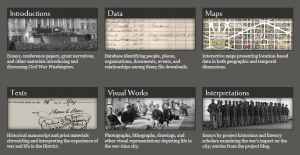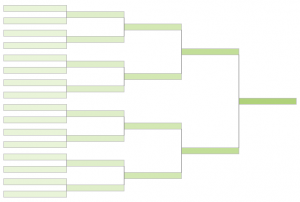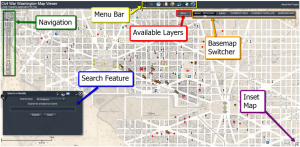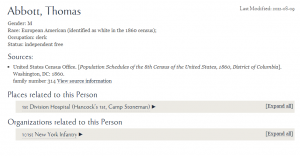The digital humanities project, “The Future of the Past” is a unique use of digital humanities methods. When scrutinized under the figurative lens of Shannon Mattern’s Criteria for Evaluating Multimodel Work, one can understand why it awarded “Best use of digital humanities project for fun” by the expert consortium administering the annual DH Awards: It is fun but it is perhaps not entirely effective. To simplify her criteria we made our own rubric to analyze it.
For readers unfamiliar with the project, a brief overview can be found on the website by clicking “the story…” on the right side of the homepage. This provides an overview of how the author, Tim Sherrat, turned 10,000 newspaper articles into a digital humanities project. His aim was to archive every Australian news article from the 19th and 20th centuries that contained the phrase “the future” and create a site to explore how the future was perceived in the past. Sherrat’s website includes evidence of research, links to his sources, and links to/from his site to reinforce his underlying thesis in a cohesive manner. That is, that throughout time the future has been discussed throughout the past in different contexts. On the website , a link can be found to the newspaper he used which demonstrates use of citations and academic integrity – imperative components of Mattern’s ideal digital humanities model.
He extracted every word from his archive of collected articles containing the word ‘future’ and made a database. He then made an interactive word-based interface so that whenever a reader accesses the site they find a compilation of words from the articles that act as hyperlinks.
It is through this organization that he was able to take the newspaper articles and recontextualize them into a format useful for his digital humanities project. One particularly impressive aspect of Sherrat’s project was how much feedback he
received – and his constructive dialogue with users – throughout the developmental stages of his site . Clicking “The Story” allows the site’s viewers to follow Sherrat’s creative process. Additionally, he live tweeted his progress in real time, and people tweeted at him with questions about his project, which he appeared to happily reply to. These tweets act as a form of pseudo-peer review. A series of lectures explaining his project allowed additional public understanding. This would not necessarily be considered a form of collaboration, as he was and continues to develop this project on his own, but the public input serves a form of joint effort.
Exploration of the website, and use of the tools he provides make it easy to deduce that Sherrat has a very clear vision, and a comprehensive understanding of the mechanisms behind his project. However, the format of the website is the project’s biggest downfall – the tool is simple enough to use (user friendly) because one just points and clicks, but there is no balance with something new other than the format of site. Despite the simplicity of the point and click if someone were to come to the page on their own it would be difficult for them to grasp what the site was attempting to achieve. Although it does not initially appear accessible, reading “the story…” provides some clarity. Additionally, if one came to the site to learn about how others viewed the past, it would only be a random acquisition of knowledge rather than a particular route. A direct search for a particular year, event, or phrase is not possible which makes it less useful then one would hope for. Perhaps we are not entirely grasping what he is trying to achieve which would make our critique a little unfair. If he is trying to achieve a database to allow for random knowledge acquisition (which is maybe suggested by winning the Fun category) then he effectively created such a database. From our perspective, however, it appears as if this is not the most conducive format for this project, because you cannot purposefully acquire knowledge.
Despite our inability to determine the exact purpose of the site we will proceed the rest of the way under the impression that it is made for random knowledge acquisition. Under these conditions it is appropriately formatted and effectively organized. The fact that each time you open the page a random subset a words appears, which will lead you on a different path each time, is an innovative way to create a site and to organize this information. But how well this page is linked together, its cohesiveness, is arguably the most difficult criteria to judge. If it is judged based on the understanding that it is supposed to be random then yes, the fact that it is a jumble of words that allows you to arbitrarily click on an appealing word and learn more is fantastic. Conversely, if a reader wants to acquire specific data then we would dispute how cohesive the page is.
Since Sherrat appears to demonstrate a mastery of the tool it is therefore adaptable. Mastery correlates with adaptability because a complete understanding of how the tool (the tool being the way he tied together all the words) suggest that changes could be made if the site needed to adapt. It is this adaptability that is one of the most exciting aspects of the project. If he were to come across more data he could expand upon the comprehensiveness of the database. Currently, the data is limited to a certain time and geographic range (Australia). However, if he were to collaborate with partners in various nations he could expand upon the database so that readers could learn “The Future of the Past” of more nations across a longer expanse of time. With such an extensive database, readers could compare not only “the future” across time, but across space. Another improvement we would suggest is a more comprehensive explanation of how to use the site because a better understanding allows for a more user friendly experience. Wouldn’t it be nice too to have different navigation interfaces if the world-link interface is not useful to you? If the back-end database is robust and adaptable, we should be able to feed that data into multiple interfaces allowing for very different web ‘faces’.
Based on Shannon Mattern’s Criteria, Sherrat created an approvable digital humanities project. It fulfills most of the requirements she presents, and its adaptability allows for it to potentially fulfill the rest. Overall, it is an impressive project that understandably won the award for “Best use of digital humanities project for fun.”
Co-Authors: Shane and Joy
Thank you to Amanda Gould for her assistance in reviewing our work







